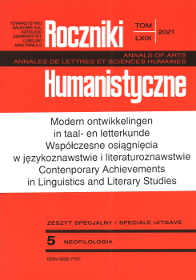Super-diversity and Cultural Mobility in European Higher Education: A Case Study in Cultural History
Abstract
The present article shows how the changing societal context in Europe is imposing a reshaping of the internationalisation of higher education. It argues that internationalisation has mainly focused on intensifying the mobility of students and staff, but has neglected the drastic change in European society brought about by “super-diversity” (Vertovec, “Super-diversity” and Super-diversity), that “diversification of diversity” which, over a couple of decades, has transformed the population of Europe into a highly complex mixture of people from different places, with different languages, religions and cultures. The consequence of this sudden change is that there is now an urgent need to “move beyond mobility” and to reshape internationalisation through “cultural mobility” (Greenblatt) in course content and learning styles. The second part of this article elaborates on a proposal for concrete course content in line with Greenblatt’s manifest to modify conventional ways of thinking about mobility. Taking account of “cultural mobility”, the proposed course in the Cultural History of the Arts tries to create a balance between cultural persistence and cultural change by introducing international content and interculturalism. The case study thereby highlights possible directions for future internationalised course development.
References
Alpers, Svetlana. The Art of Describing. Dutch Art in the Seventeenth Century. The University of Chicago Press, 1983.
Barker, Mary Christine. “Transcending Tradition: Rembrandt’s Death of a Virgin 1639: A Re-Vision.” Dutch Crossing, vol. 34, nr. 2, 2010, pp. 138-161.
Baxandall, Michael. Painting and Experience in Fifteenth Century Italy. Oxford University Press, 1972.
Baxandall, Michael. Schilderkunst en leefwereld in het Quattrocento. SUN, 1986.
Beheydt, Ludo. Eén en toch apart. Kunst en cultuur van de Nederlanden. Davidsfonds & Waanders Uitgevers, 2002.
Beheydt, Ludo. “Art and Cultural Identity of the Low Countries.” Lectures for the XXIst century, onder redactie van Bart Raeymakers, Leuven University Press, 2008, pp. 261-284. .
Beheydt, Ludo. “Een semiotische interpretatie van het werk van de Vlaamse primitieven tegen de achtergrond van de Bourgondische cultuur.” De Nederlandstalige cultuur internationaal. Centraal-Europa en de Lage Landen, onder redactie van Jana Engelbrechtová, Univerzita Palackého v Olomouci, 2015, pp. 3-37.
Beheydt, Ludo. “European influence of Dutch and Flemish Art.” Dutch-Flemish-Central European Relations, onder redactie van Jana Engelbrechtová, Palacký University in Olomouc, 2015, pp. 9-23.
Brown, Christopher. The Dutchness of Dutch Art. Amsterdams Centrum voor de Studie van de Gouden Eeuw, Universiteit van Amsterdam, 2002.
Burke, Peter. Cultural Hybridity, Polity Press, 2009.
Dacos, Nicole. “Om te zien en te leren.” Fiamminghi a Roma. Kunstenaars uit de Nederlanden en het Prinsbisdom Luik te Rome tijdens de renaissance, onder redactie van Hans Devisscher, Snoeck Ducaju & Zoon, 1995, pp. 14-31.
DaCosta Kaufmann, Thomas. Toward a geography of art. The University of Chicago Press, 2004.
De Jongh, Eddy. “Real Dutch art and not so-real Dutch art: some nationalistic views of seventeenth-century Netherlandish painting.” Semiolus: Netherlands Quarterly for the History of Art 20, 1990, nr. 92, pp. 197-206.
European Commission Communication COM(2020) 625 final. “Achieving the European Education Area by 2025.” Europese Commissie. ec.europa.eu/education/resources-and-tools/ document-library/eea-communication-sept2020_nl. Geraadpleegd 30.9.2020.
Frijhoff, Willem, en Marijke Spies. Dutch Culture in a European Perspective. Hard-Won Unity. Van Gorcum & Palgrave Macmillan, 2004.
Gogolin, Ingrid. “The Challenge of Super Diversity for Education in Europe.” Education Inquiry, vol. 2, nr. 2, 2011, pp. 239-249.
Greenblatt, Stephen (editor). Cultural Mobility: A Manifesto. Cambridge University Press, 2010.
Hoogewerff, Godefridus J. De Noord-Nederlandsche schilderkunst. Martinus Nijhoff, 1947.
Huisman, Jeroen. “Europeanisation and higher education: comfortable bedfellows?” University adaptation in difficult economic times, onder redactie van Paola Mattei, Oxford University Press, 2014, pp. 118-136.
International Association of Universities. Affirming Academic Values in Internationalization of Higher Education: A Call for Action. 2012, iau-aiu.net/IMG/pdf/affirming_academic_values_in_internationalization_of_higher_education.pdf. Geraadpleegd 30.9.2020.
Kemperdick, Stephan. Rogier van der Weyden. Könemann, 1999.
Knight, Jane. “Updated Internationalisation Definition.” International Higher Education, vol. 33, 2003, pp. 2-3.
Landau, David, & Peter Parshall. The Renaissance Print. 1470-1550. Yale University Press, 1994.
Leask, Betty. “Bridging the Gap: Internationalizing University Curricula.” Journal of Studies in International Education, vol. 5, nr. 2, 2001, pp. 100-115.
Marginson, Simon, & Marijk van der Wende. “Globalisation and Higher Education.” OECD Education Working Papers, vol. 8, 2007. Doi: 10.1787/173831738240.
Schama, Simon. The Embarrassment of Riches. An Interpretation of Dutch Culture in the Golden Age. Fontana Press, 1987.
Schwartz, Gary. “The destigmatization of art geography: a preliminary to the study of the Dutchness of Dutch art.” Nationale identiteit en historisch besef in Nederland, onder redactie van Els Kloek & Leen Dorsman. Utrechtse Historische Cahiers, vol. 14, nr. 4, 1993, pp. 1-14.
Schwartz, Gary. “Johannes Vermeer was not a typical Dutch artist.” De Gids, vol. 167, 2004, nr. 5-6, pp. 445-450 (English edition). Vertaling: “Johannes Vermeer was geen typisch Hollandse schilder.” De Gids, vol. 167, nr. 5-6, 2004, pp. 445-450 (Nederlandse uitgave).
Schwartz, Gary. “There is no Such Thing as ‘Dutchness’ or ‘Flemishness’ in Seascape Painting.” The Low Countries: Arts and Society in Flanders and the Netherlands, vol. 23, 2015, pp. 88-97.
Van Mander, Carel. Het Schilder-boeck van Carel van Mander. Het leven der doorluchtige Nederlandsche en Hoogduitsche schilders. Amsterdam, Wereldbibliotheek, 1946 (oorspronkelijke uitgave 1604).
Vassiliou, Androulla. “Cultural diversity, global politics and the role of Europe.” Speech at Harvard University, Boston, 28 February 2014, europa.eu/rapid/press-release_SPEECH-14-165_en. htm?locale=en. Geraadpleegd 15.04.2020.
Vertovec, Steven. “Super-diversity and its implications.” Ethnic and Racial Studies, vol. 30, nr. 6, 2007, pp. 1024-1054.
Vertovec, Steven. Super-diversity. Routledge, 2014.
Vögle, Eva Maria. “20 Years of Bologna – a story of success, a story of failure.” Innovation: The European Journal of Social Science Research, vol 32, issue 4, 2019, pp. 406-428. Doi: 10.1080/13511610.2019.1594717.
Westermann, Mariët. A Worldly Art. The Dutch Republic 1585-1718. Prentice Hall & Harry N. Abrams, 1996.
Wheelock, Arthur. “De bruiloft te Kana.” Jan Steen. Schilder en verteller, onder redactie van H. Perry Chapman, Wouter Kloek & Arthur K. Wheelock. Waanders Uitgevers, 1996, pp. 238-240.
Copyright (c) 2021 Roczniki Humanistyczne

This work is licensed under a Creative Commons Attribution-NonCommercial-NoDerivatives 4.0 International License.





